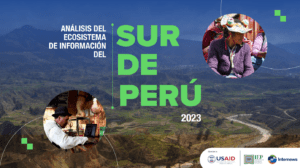Read the Information Ecosystem Assessment
The following research was conducted by the Instituto de Estudios de Peruanos (IEP) in coordination with Internews. The information ecosystem research took place between June and July 2023 in the eight departments of southern Peru: Apurímac, Arequipa, Ayacucho, Cusco, Ica, Moquegua, Puno and Tacna. All are not only characterized by abundant natural, historical and cultural resources, but also by multiple socioeconomic deficiencies.
This report presents the main communication needs and challenges of communities to stay informed and share information. In addition, it explores trust in the media in the southern region of Peru. It shows that more than half of those surveyed say they prefer to be informed through social media networks, a figure that increases considerably among those under 40 years of age. Underscoring the importance of social media networks, 8 out of 10 respondents use some social network, such as Facebook, TikTok, WhatsApp or others, to find, read or watch news during the week.
Social media networks are the medium that 37% of the population relies on for news information. This percentage is far above traditional media, such as radio (which represents the main source for 21% of the population) or television (the primary source for 18%). When asked the source they rely on for information, 29% of respondents identified journalists, while 28% noted friends and relatives.
Meanwhile, 78% indicated that they have had experience with disinformation, while 21% have not had the opportunity to read or review disinformation. Although this type of content is frequent, 67% said that they can only sometimes differentiate between a piece of news that is true or false.
Patricia Zárate, head of the IEP’s Opinion Studies area, coordinated this research. Clara Robayo served as the Internews program officer for this project.
Análisis del Ecosistema de Información del Sur de Perú
La siguiente investigación fue realizada por el Instituto de Estudios de Peruanos (IEP) en coordinación con Internews. La investigación sobre el ecosistema de información se realizó entre junio y julio de 2023 en los ocho departamentos que conforman el sur de Perú: Apurímac, Arequipa, Ayacucho, Cusco, Ica, Moquegua, Puno y Tacna. Todos ellos caracterizados por gozar de abundantes recursos naturales, históricos y culturales, pero también por contar con múltiples deficiencias socioeconómicas.
El documento presenta las principales necesidades de comunicación y los retos de las comunidades para mantenerse informadas y compartir información. Además, explora la confianza en medios de comunicación que tienen la región sur de Perú. También muestra que más de la mitad de los encuestados señala que prefiere informarse por redes sociales, cifra que aumenta considerablemente entre los menores de 40 años. Tal es la importancia de las redes sociales que 8 de cada 10 encuestados utilizan alguna red social, como Facebook, TikTok, WhatsApp u otra, para encontrar, leer o mirar noticias en la semana.
Las redes sociales son el medio en que confía el 37% de la población para informarse de noticias. Es un porcentaje que está muy por encima de medios tradicionales, como la radio, que representa el 21% o la televisión, el 18%. Al preguntar sobre las personas confiables para informarse, aparecen tanto los periodistas con 29%, como los amigos y familiares con 28%.
Con relación a la experiencia con noticias falsas, el 78% señaló que sí ha vivido esta experiencia, mientras que el 21% no ha tenido la oportunidad de leer o revisar noticias falsas. Pese a ser frecuente el acercamiento a este tipo de contenido, el 67% señala que solo algunas veces puede diferenciar si una noticia que recibe es verdadera o falsa.
La investigación fue coordinada por Patricia Zárate, jefa del área de Estudios de Opinión del IEP. Clara Robayo fue la oficial de programas en Internews para este proyecto.
